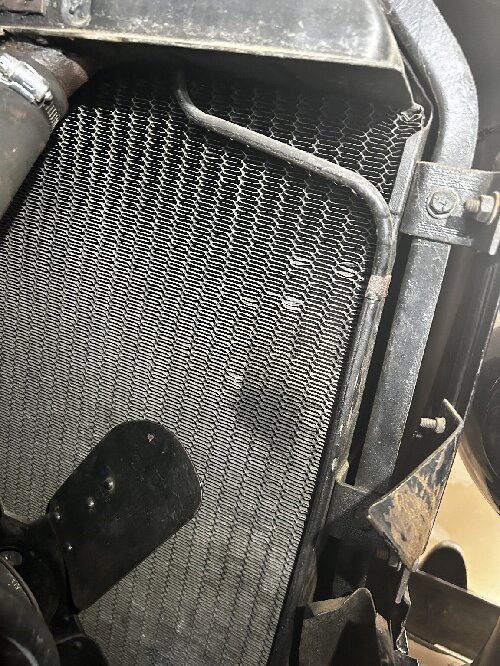|
Re: 1937 120 Conv. Sedan - Blanche
|
||||
|---|---|---|---|---|
|
Home away from home
|
Thx Tx. So it sounds like it is normal.
I just saw something that I have not seen or at least recognized before. What’s this tube for coming out of the radiator? Is it for air flow? It just goes down to the bottom but to nothing so I assume it is to get air to help circulation? It then had me questioning how much coolant I should be putting in as the tube is on the bottom of the overflow tank. I do see some coolant on the frame below where the tube ends. Not sure if that is one of the sources of my “leak”? 
Posted on: 2024/5/29 11:15
|
|||
|
||||
|
Re: 1937 120 Conv. Sedan - Blanche
|
||||
|---|---|---|---|---|
|
Home away from home

|
That tube is the overflow tube. If coolant level gets too high it drains out that tube and onto the ground. If your cooling system is unpressurized (I'm pretty sure it's unpressurized) then the tube sticks up a certain amount in the upper tank. Any coolant above that level goes in the tube and out to the road. My dad's '38 Super is this way, except the overflow tube is located under where the cap is.
Posted on: 2024/5/29 11:27
|
|||
|
||||
|
Re: 1937 120 Conv. Sedan - Blanche
|
||||
|---|---|---|---|---|
|
Home away from home
|
ok. Thanks. That makes sense. It must be raised up a bit in the tank, as when i fill it, it does not come out, nut it looks like it does when I am driving, or when it gets hot.
Posted on: 2024/5/29 12:08
|
|||
|
||||
|
Re: 1937 120 Conv. Sedan - Blanche
|
||||
|---|---|---|---|---|
|
Webmaster
|
Sounds fairly normal based as when idling you are getting the least amount of airflow through the radiator and fan isn't turning as fast.
Posted on: 2024/5/29 12:10
|
|||
|
-BigKev
1954 Packard Clipper Deluxe Touring Sedan -> Registry | Project Blog 1937 Packard 115-C Convertible Coupe -> Registry | Project Blog |
||||
|
||||
|
Re: 1937 120 Conv. Sedan - Blanche
|
||||
|---|---|---|---|---|
|
Home away from home
|
At one point Packard offered an optional fan for the 110 and 120. (Service bulletins or shop manual) They warned that the optional fan would be noisier than the standard fan and would pull more power. I think the '36 and '37 cars had an improved fan as standard equipment. One problem with a higher capacity fan is that it will require more power at highway speeds, and that will require a tighter fan belt, which the water pump bushings will not like. My car has an electric fan attached in front of the radiator and operated with a manual switch. It helps cooling at low speeds, but it draws a lot of amps. I suspect it may actually block airflow somewhat at higher road speeds. It would be an advantage in heavy traffic or in a parade in hot weather, but the substantial current draw taxes the stock generator. A good clutch fan would be nice, but there isn't room for such a thing. The '36 & '37 hood louvers look very restrictive to me, and the engine compartment is not nearly as well ventilated as most. The inner fender panels on my car are too nice to cut up, but I'd think a custom pair of fender panels made much like the 1938 ones would substantially improve cooling. The '36 & '37 inner fender panels lack any concession to ventilation.
Posted on: 2024/5/29 17:23
|
|||
|
||||
|
Re: 1937 120 Conv. Sedan - Blanche
|
||||
|---|---|---|---|---|
|
Home away from home
|
Thx guys. Will just need to keep an eye on the temp gauge.
Back to the ammeter. I took her out last night, and noticed that when I turned on the lights, the ammeter ticks up on the positive side now. Not much, probably 5-10. Again, is this normal when lights are on?
Posted on: 2024/5/31 7:52
|
|||
|
||||
|
Re: 1937 120 Conv. Sedan - Blanche
|
||||
|---|---|---|---|---|
|
Home away from home
|
Any electrical load should pull the ammeter toward the negative direction. The ammeter could still show positive if you are driving and the battery is charging, but it will be less positive with lights/electrical load. With the car not running the ammeter should definitely show negative if you turn the lights on.
Posted on: 2024/5/31 8:22
|
|||
|
||||
|
Re: 1937 120 Conv. Sedan - Blanche
|
||||
|---|---|---|---|---|
|
Home away from home
|
Thanks Don. So previously, it was showing negative at start-up, idle and driving. I reversed the wires on the ammeter, and that corrected that, where it was now reading 0 at start idle and driving. Now it is positive when lights are on. This occurs when the car is turned on or off.
What is the suggestion? Reverse the wires again?
Posted on: 2024/5/31 8:53
|
|||
|
||||
|
Re: 1937 120 Conv. Sedan - Blanche
|
||||
|---|---|---|---|---|
|
Home away from home
|
It sounds like you probably had it wired correctly before. It should definitely read negative with lights on and the car off. With the car on at normal idle and lights on it may still read negative. But, when you increase the idle it should go positive when charging.
Posted on: 2024/5/31 10:13
|
|||
|
||||








